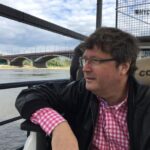Warsaw 1930s
Warsaw before WWII – William Jensen visited Warsaw ind the 1930s and gives a description of a rich and cheerful city characterized by contradictions and poverty.
#Warsaw tour guide #Warsaw city guide # guided tour in warsaw #Warszawa tour guide #Warszawa city guide #guided tour in Warszawa
“Although Warsaw will celebrate its 350th anniversary as the capital of Poland in a few years’ time, and despite its eventful political, historical and cultural past, it is by no means what you would call a “truly Polish” city. It’s too modern for that, too much influenced by contemporary Western European culture. Warsaw has so many faces that it really has no face”.
Warsaw 1930s – City of Contrasts
The above quote is from the Danish author William Jensen, who in 1938 published the book “Poland – Land of Contrasts”, and one of the chapters was titled “Warsaw – City of Contrasts”. Jensen paints a picture of a beautiful and bright city centre, which is actually reminiscent of many of the same elements that exist in a reconstructed form in today’s Warsaw – he mentions the Sigismund Column in front of the Royal Palace, the city’s functionalist skyscrapers, frescoes, the Cathedral of St. John the Baptist and the Rynek or market square in the Old Town. He describes Rynek, where the current buildings were constructed around 1600, after the end of the Swedish Wars: “Everything is old, and such an atmosphere of mystery and medievalism hovers over the square that you can’ t help but immerse yourself in the story these venerable old walls are telling”.
Krakowskie Przedmiejsce magnificent buildings and castles
However, Jensen is particularly enthusiastic about Krakowskie Przedmiejsce, which he describes as a street where “one magnificent building follows another, and where one historic castle sits next to another”. And a little later, he continues: “Hardly any other street in the world can boast such a large number of castles, churches and other magnificent buildings in such a short distance as Krakowskie Przedmiejsce in Warsaw”. Finally, he notices the Royal Academy of Science with Thorvaldsen’s statue of Copernicus, while noting how people bow their heads or take off their hats to Christ with the crown of thorns facing the Church of the Holy Cross. He also notices the abundance of flowers everywhere and characterises the city as “a little Paris”.

Krakowskie Przedmiejsce: Thorvaldsen’s statue of Copernicus seen from behind and the Church of the Holy Cross
Photo: Public domain.
Krakowskie Przedmiejsce magnificent buildings and castles
However, Jensen is particularly enthusiastic about Krakowskie Przedmiejsce, which he describes as a street where “one magnificent building follows another, and where one historic castle sits next to another”. And a little later, he continues: “Hardly any other street in the world can boast such a large number of castles, churches and other magnificent buildings in such a short distance as Krakowskie Przedmiejsce in Warsaw”. Finally, he notices the Royal Academy of Science with Thorvaldsen’s statue of Copernicus, while noting how people bow their heads or take off their hats to Christ with the crown of thorns facing the Church of the Holy Cross. He also notices the abundance of flowers everywhere and characterises the city as “a little Paris”.
The old prison at the Citadel in Warsaw 1930s
Jensen also take a trip past the citadel, which is still one of my personal favourite places to visit on the river. There are plans to build a “museum of martyrdom” (which has now been constructed), and he mentions the old gallows and the symbolic crosses of the executed Polish freedom fighters – elements that can still be seen in today’s Warsaw. Jensen describes his visit to the old prison, which was primarily intended for rebels against the Russian regime:
Memorial plaques show, who lived in the cells
“In the various buildings, or “pavilions” as they are called, memorial plaques have been placed in the cells to say that this or that person lived here, and many of these cells still have the original heavy doors with a square hole in them. This is the guard’s peephole, through which he could see the entire interior of the cell. But when the prisoners looked out through the hole, all they saw was a piece of glass with a human eye painted on it – so lifelike that the prisoners thought they were under constant surveillance! A few prisoners must have gone insane at the thought of this constant staring into the cell.”
Warsaw is turning away from the river
He also describes how the city seems to be turning away from the Wisła River, whose banks seem like a backyard of small sheds and fishing boats, but Jensen also notes a trend of increasingly using the riverbank for recreational purposes.
Warsaw 1930s: Etnic tensions between Jews and Catholics
It also highlights the latest fashion – ice cream, which is delicious and hygienic, unlike the “unappetising outlets in poor neighbourhoods, where for a few groszy you could get a nondescript, ice-cold nothing, scooped out of a bucket that was justifiably called a ‘bacillus bucket’. The ethnic-inspired adverts are also mentioned: Here you can buy real Polish ice cream” – they say or write across the shop fronts: “This is a Christian company”. And with these sentences, of course, we hit the poor neighbourhoods of the capital, but also the ethnic tensions between Catholics and Jews. Finally, the riverside is mentioned, which to this day does not always feel like an integral part of the city.
The trams are crowded
But after visiting all the beautiful places in Warsaw, he moves on to the contrasts – the many people who, due to deep poverty, can’t afford a Sunday outing in the green, the crowded trams where you have to push your way through to (maybe) get off at your planned stop.
You pay the porter to be let in at night
William Jensen also notices the porters, which are also mentioned in Brandes’ ‘Impressions from Poland’ from the late 1800s. You pay 25 groszy to be let in at night when the doors are closed and no residents are given their own key to the front door. This also means that the police can check who has visited the building at any time. In other words, the old Russian police control has been transferred to the new system.
The Jewish neighbourhood is described as “a distant Asian country”
But after painting the city in relatively beautiful strokes, the book moves on to poverty and decay. The old town of Warsaw is inhabited by “Jews and poor petty traders”. The Jewish neighbourhood proper is described as “a distant Asian country. The houses are neglected, and sometimes they are nothing more than dilapidated board houses. The streets smell of dirt, and for five days a week, much of the shopping takes place in the middle of the pavement.” It goes on to describe the Jewish trading methods with lengthy haggling over price and how the Jews are unpopular in Poland, where 87% of them speak their own language, have their own newspapers and their own cultural life, which William Jensen clearly does not like. The term ghetto wasn’t used to describe the Jewish neighbourhood at the time, but it was undoubtedly a city within the city. A large number of contemporary authors describe the neighbourhood in the same way as Jensen, and his description is undoubtedly correct.
Some descriptions are valid today
Overall, it’s a poignant description of the city, much of which remains valid today – 80 years later. But it might be a little too beautiful. The sections on Warsaw deals with the poverty and decay, but associate it too strongly with the Jewish population. And there’s a lot of decay all over the city at that time, even among the poor Polish labourers, with buildings being built too densely and a third of the city’s streets being dirt roads.
Please send an email to m@hardenfelt.pl if you would like an English-speaking tour guide to show you the most important places in Warsaw.

